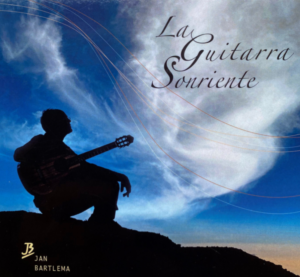
Gitarist Jan Bartlema vertelt een fantastisch muzikaal verhaal op zijn nieuwe album La Guitarra Sonriente.
English version below
Gitaarspelen, dat doen er zo velen, maar spelen èn een muzikaal verhaal vertellen, dat is andere koek. Klassiek gitarist Jan Bartlema laat zijn gitaar huilen, dansen, wenen en springen. Het komt allemaal voorbij op zijn laatste CD La Guitarra Sonriente. Hij speelt werken van negen componisten, waaronder de Mexicaan Manuel Ponce (1882-1948), de tango-vernieuwer Astor Piazolla, de Cubaan Leo Brouwer, de Spaanse gitaar-componist Fernando Sor (1778-1839) en werken van Bartlema zelf. Een breed scala aan componisten dat ook een uitgebreid repertoire voorspelt. En dat komt er ook. Het album opent met het ongelooflijk mooie Caprice no. 1 van de Tsjechische componist Milan Tesar (1938-2019). Een caprice, een levendig werk vol syncopen en een rijke melodie wat door Bartlema met een opgewekte levendigheid wordt gespeeld, waar de vonken vanaf spatten. Fraai hoe hij in stukken als Study in B minor van Sor, Piazolla’s Verano Porteño of Un Dia de November (Leo Brouwer) de melodie zeer vakkundig boven de begeleiding uittilt. Dat is een van de uitdagingen van elke klassiek gitarist. De partijen zó spelen dat je het thema laat prevaleren, waardoor deze net iets meer aandacht krijgt. Het tegenovergestelde gebeurt overigens in zijn eigen compositie Elegy, dat gebaseerd is op arpeggio’s (akkoord-brekingen) waarmee hij een glooiend muzikaal landschap creëert en je meeneemt naar een weemoedig tafereel.
Bartlema wordt bijgestaan door pianist Rudi Kaldenberg in vier werken van de Oostenrijkse componist Gerald Schwertberger. Een nieuwe combinatie dus: de piano/gitaar sensatie, die je niet zo vaak tegenkomt in het klassieke repertoire. De muziek excelleert in diepte en krijgt een breder klankspectrum, zeker de muziek van Schwertberger. Voor zijn luisterrijk werk Cuatro Piezas para Dos haalde Schwertberger zijn inspiratie uit de Renaissance muziek, de tango en Zuid-Spaanse muziek, met zo nu en dan een ritmisch geroffel op de gitaar als ware het een cajon (klein percussie-kistje) in het vierde deel Vivo (levendig). In Berceuse (van Leo Brouwer) horen we gemuteerde gitaarklanken waarbij Bartlema de snaren soms dempt met zijn rechterhand waardoor ze doffer en ietwat mistig klinken wat goed past bij een slaapliedje. La Guitarra Sonriente (De lachende gitaar) is een fantastisch album van een gitarist die zich als een vis in het water voelt, het gitaarrepertoire helemaal naar zijn hand zet en dat met veel spelplezier laat horen!
-
Luister hier naar het volledige album
English version
Guitarist Jan Bartlema tells a fantastic musical story on his new album La Guitarra Sonriente.
A lot of people play the guitar. But playing the guitar and telling a musical story, that’s what he does. Classical guitarist Jan Bartlema makes his guitar cry, dance, weep and jump. All these moods you can find on his latest CD La Guitarra Sonriente on which he plays works by nine composers. Including the Mexican Manuel Ponce (1882-1948), the tango innovator Astor Piazolla, the Cuban Leo Brouwer, the Spanish guitar-composer Fernando Sor (1778-1839) and works by Bartlema himself. A wide range of composers that also predicts an extensive repertoire. And so it will be. The album opens with the incredibly beautiful Caprice no. 1 by the Czech composer Milan Tesar (1938-2019). A caprice, a lively work full of syncopation and a rich melody played by Bartlema with a cheerful liveliness. Nicely how Bartlema in pieces like Study in B minor by Sor, Piazolla’s Verano Porteño or Un Dia de November (Leo Brouwer) very skilfully lifts the melody above the accompaniment. That is one of the challenges of every classical guitarist. Play the music in such a way that you let the melodie prevail and give it a little bit more attention. The opposite happens in his own composition Elegy, which is based on arpeggios (chord breaks) in which he creates a flowing musical landscape and takes you into a melancholy scene.
-
Listen here to the entire album
Bartlema is assisted by pianist Rudi Kaldenberg in four works by the Austrian composer Gerald Schwertberger. A new combination is the piano/guitar sensation that you don’t often hear in the classical repertoire. The music excels in depth and acquires a broader sound spectrum, especially the music of Schwertberger. In his glorious pieces Cuatro Piezas para Dos Schwertberger drew his inspiration from Renaissance music to tango and southern Spanish music, with the occasional rhythmic drumming on the guitar, so it sounds like a cajon (small percussion box) in the fourth part Vivo (lively). In Berceuse (by Leo Brouwer) we hear mutated guitar sounds in which Bartlema sometimes mutes the strings with his right hand, making them sound duller and somewhat misty, which fits very well in the lullaby. La Guitarra Sonriente (The Laughing Guitar) is a fantastic album by a guitarist Jan Bartlema who moves like a fish in clear musical water. Creating his own musical signature which he shows with great pleasure!
- Jan Bartlema: La Guitarra Sonriente (Marista)
© Mattie Poels.

Geen reacties